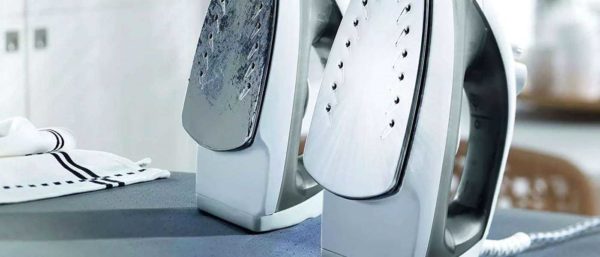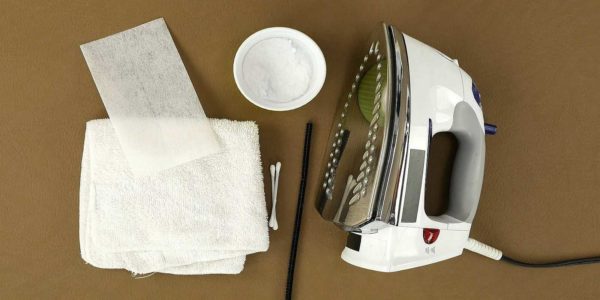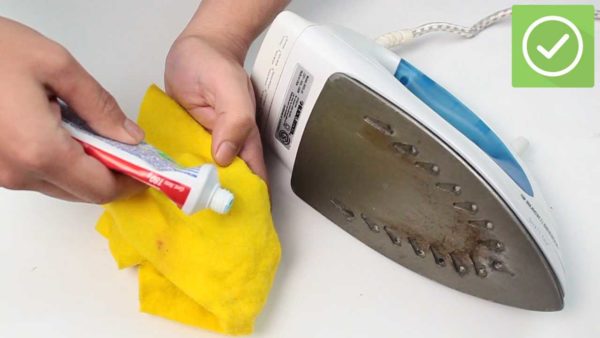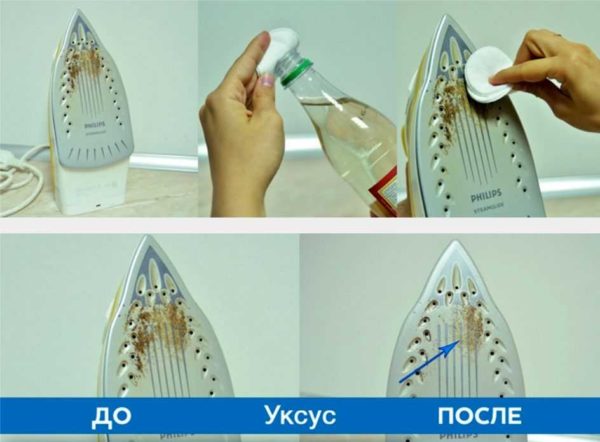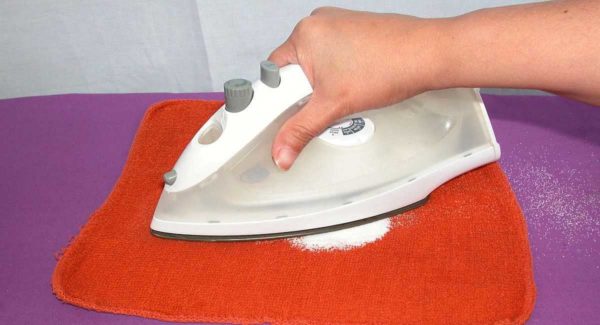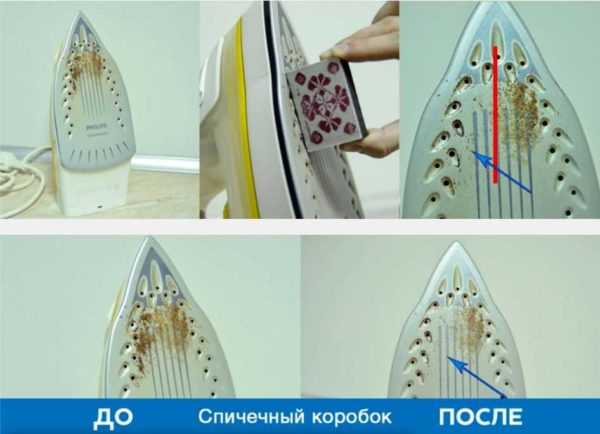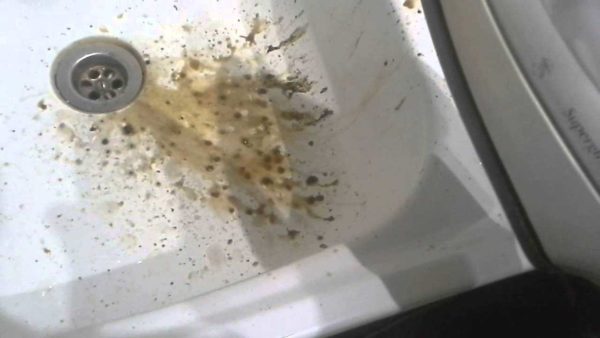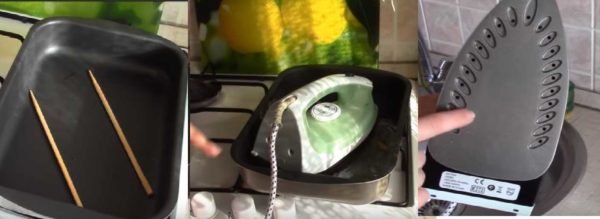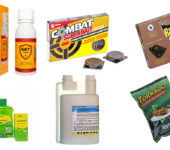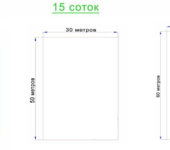How to clean the iron from the burn on the sole, scale inside
Even a good iron has brown or black spots on the sole sooner or later. They do not interfere with ironing at first. In any case, we do not notice that they interfere. But over time, ironing becomes more and more difficult - the sole does not slip due to carbon deposits. It would seem, what's wrong with that? We take and clean off the burnt. But it's not that simple. If the ceramic or Teflon surface is scratched, the iron can be thrown away. So, before you clean your iron, choose the appropriate method or product.
The content of the article
We clean the iron from burning on the sole
With an incorrectly selected iron heating mode, a yellowish bloom forms on the sole. It makes the sole rougher, which makes it less likely to slide on the fabric and becomes more difficult to iron. If this carbon deposit is not removed in time, it will turn brown, then black. The darker the color, the more difficult it is to remove plaque. If your iron is expensive, it is better to remove plaque after ironing. Ideally, right after it appears. Even if you do a gentle cleaning once a week, it will be enough.
Home cleaning technique
First, how to clean the soleplate of your iron. We take a clean, dry cloth made from natural fabrics. It is very nice if it has a rough weave, but not necessary. The rag must be folded several times, put on the ironing board. We apply a liquid or pasty composition to it, distributing it over most of the surface. With a preheated to medium temperature or with a cold iron, we begin to “iron” a cloth with a cleaning agent. This should be done for several minutes. It is advisable to remove the plug from the socket during cleaning. Usually alkaline or acidic components are used, so it is better not to risk it, otherwise you will also have to repair iron.
In some cases, if the rag is saturated with caustic ingredients, you can simply leave the iron on the rag for a while. When the carbon is softened, you can iron a dry or damp cloth, but already clean. If not all carbon deposits have been removed, we repeat the treatment. If it doesn't help at all, try a different method or composition.
Some cleaning products (baking soda, salt, toothpaste) can clog the steam pores on the soleplate of the iron. A rag soaked in vinegar can help. We also iron it with a heated iron. Another way is to pour water with vinegar and "release" all the liquid in the form of steam. Keep the sole pointing downwards. By the way, this will also clean up the scale that forms in steaming irons.
Cleaning compounds
To say unequivocally - it works, but it does not - will not work. First, the type of burn is different. Secondly, the ironing soles are also different. Not only the shape differs, but also the materials. What works on ceramics may not work on metal. And vice versa. You often have to try several options. Interestingly, the one that worked this time won't necessarily help the next. So you constantly have to experiment.
Composition for application to a clean cloth:
- Mix baking soda and detergent, add water until a thick slurry.
- Whitening toothpaste.
- In 9% or 6% vinegar add a couple of tablespoons of ammonia, moisten a cloth.
- You can try just vinegar. They can moisten a rag and rub the sole with it.But "ironing" a cloth soaked in vinegar is safer, and you can wipe off particularly stubborn stains.
There are also more aggressive methods. For example, take 20-25 grams of citric acid for 200 ml of water. Pour the solution into a skillet or baking sheet with high sides. Put an iron in it. The liquid should cover the sole, but should not exceed the level of the connection with the body. Leave for 20-25 minutes. Even the toughest carbon deposits are rubbed off. If you put the iron in a frying pan or baking sheet on low heat and boil, also clean well the limescale that clogs the steam nozzles. The liquid should not boil, but only be hot.
A tougher option is an acid or alkali bath cleaner. Again, different formulations work for different cases. A piece of dense polyethylene is placed on a soft rag, pressed a little in the middle so that the edges are higher than the middle. Pour the product and put an iron in the resulting puddle. The burnt spot on the sole should be dipped in acid. We are waiting for 10-15 minutes, wash with a wet cloth. Even tough dirt is removed so well. If the sole of the iron is made of stainless steel, you can safely use this method. All others - at your own peril and risk.
Dry cleaning
There is also a method for mechanical cleaning of the iron from carbon deposits, but it can be used with cheap or old copies. With those where the ceramic surface has a Teflon coating, these methods will not work. Rather, they will remove the fumes, but the sole will acquire a lot of scratches, so it will be almost impossible to use it. So before mechanically cleaning the iron from carbon deposits, we look at the sole. If there are already scratches and it does not bother you, feel free to proceed. If the surface is smooth, it's best not to take risks and try liquid products.
The essence of the method is to pour in a dry fine abrasive and drive it with an iron until the burnt fragments remain on the abrasive. We act like this. On a hard surface we spread a sheet of paper (you can use a newspaper, a magazine spread), add soda or fine table salt. We warm up the iron a little (we do not heat it), pressing it against the dry substance, we try to peel off the burnt remnants. The cleaning time depends on how much the carbon is "stuck". Sometimes the process is fast, sometimes slow, but always cleans up. Not to mirror shine, but removes blackness.
The disadvantage of this method is that if there is carbon deposits inside the grooves of the soleplate, it is very difficult to remove it. You will have to take a cotton swab, dip it in water, baking soda / salt and clean each hole this way. The boiling method works faster.
There is one more way of mechanical cleaning - with the help of sulfur on an ordinary matchbox. Sulfur strip is a fine and soft abrasive. It shouldn't even scratch the ceramic surface. It is easy to clean the carbon deposits from the iron: we scrape the carbon off the corner of the box.
Using a pencil to clean your iron
There are special pencils on sale for cleaning the sole of the iron. They may have different compositions, but the cleaning process itself is the same. First you need to protect the plastic part of the case, which is located below the sole. Masking tape is ideal. It adheres easily, adheres well and does not leave any marks after peeling off. We glue the plastic carefully.
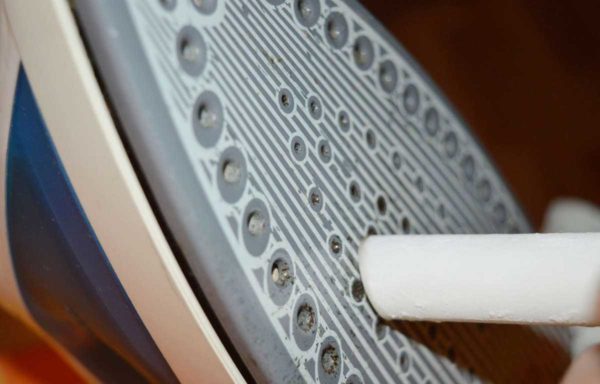
It is easy to clean the surface of the iron with a pencil. And it only takes a few minutes. Preparation lasts longer.
You will also need a clean rag or paper towels to clean the surface from residues and streaks. We put on tight working cotton gloves on our hands - steam will be generated actively and the gloves will protect from burns. It is better to cover the table with paper or old rags - dirty liquid will flow. Next, you need to clean the sole of the iron like this:
- Preheat the iron to medium temperature or higher. The higher the temperature, the faster cleaning will take place.But the vapors are very active at the same time, so ventilation should work well or can be cleaned by an open window.
- Tilt the iron so that the sole points slightly downward. The angle is chosen arbitrarily, but the composition from the melting pencil should not flow inward through the steam holes.
- With a pencil, we actively drive along the sole of the iron. It melts, immediately evaporates, some of it drips down.
- Clean the surface periodically with a rag or paper towels. When all the stains are gone, wipe the sole clean and remove the tape.
This method is one of the most effective. The price of the issue is a couple of tens of rubles, and you can use it for Teflon irons, and for steam, and for ceramic. Fast, convenient, inexpensive.
Removing scale inside
Almost all irons now come with steam - they are more convenient and efficient. During operation, scale forms inside - these are insoluble substances that water contains. They are present if non-distilled water is poured into the iron. If the iron has a self-cleaning function, turn it on periodically. If not, you will have to act differently.
Cleaning from the inside
To remove scale in the iron, pour acidified water inside. Scale is salts, the acidic environment eats them away, they loosen and come out with steam. It is better to take water as purified as possible. Better - distilled. If it is not available - boiled or after good cleaning. Add citric acid to the water. For 200 ml - about 25 grams, for a liter - 5-6 tablespoons. You can also pour alcohol vinegar (one glass of 9% per liter), but it has a more unpleasant smell.
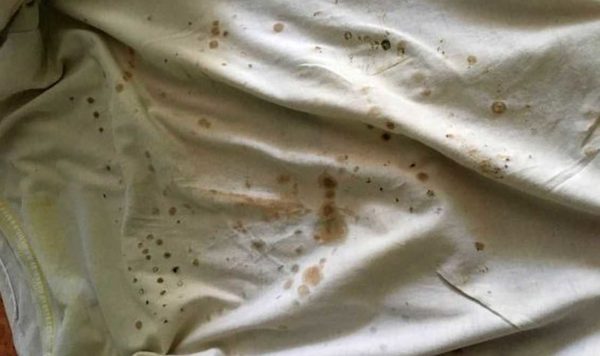
In order to clean the inside of the iron, you need to fill in water with citric acid and turn it on before heating. And this is what flows out of there
Pour the acidified water into the iron reservoir. By quantity - to the maximum. We turn on the iron to the maximum temperature. We heat until the light goes out twice or three times. Turn off the iron, go to the sink. Well we are cowardly, letting off steam. If it has cooled down, and there is still water inside, we heat it up again, turn it off and continue cleaning.
The final stage is to pour in clean water and "evaporate" all of it. You can do this over an old rag for impressions. Usually, having observed what has accumulated inside, they rarely forget to clean the iron.
Boiling
The same composition (water with vinegar or citric acid) is poured into a baking sheet with high sides. We put two sticks on the bottom (you can use it for sushi, you can just use chips). The purpose of the sticks is to provide a gap between the baking sheet and the soleplate of the iron.
We put the cold iron in a container on pieces of wood. The liquid level should be such that it covers the sole but does not reach the plastic parts. We put all this on the burner, bring to a boil, leave to cool. Heat up again, cool down. So 2-4 times. Next, you need to drain the water that got inside the iron through the steam holes. You can drain it through the filler hole. The water will not be clear, usually yellow with limescale residues.
Pour clean water inside the iron, rinse and pour out. Next, you need to leave it alone until it dries. After a couple of hours, you can turn on and try to iron.

